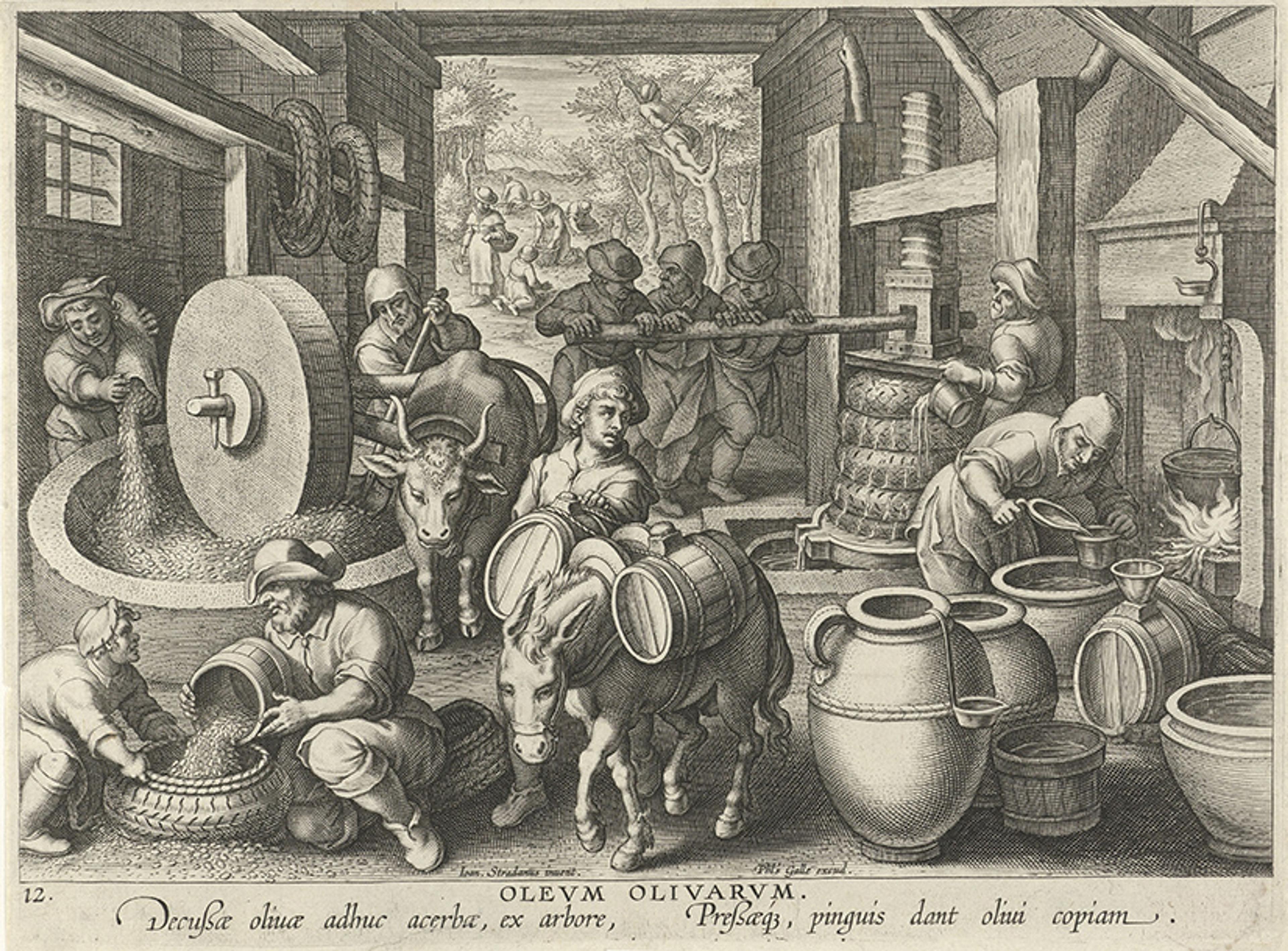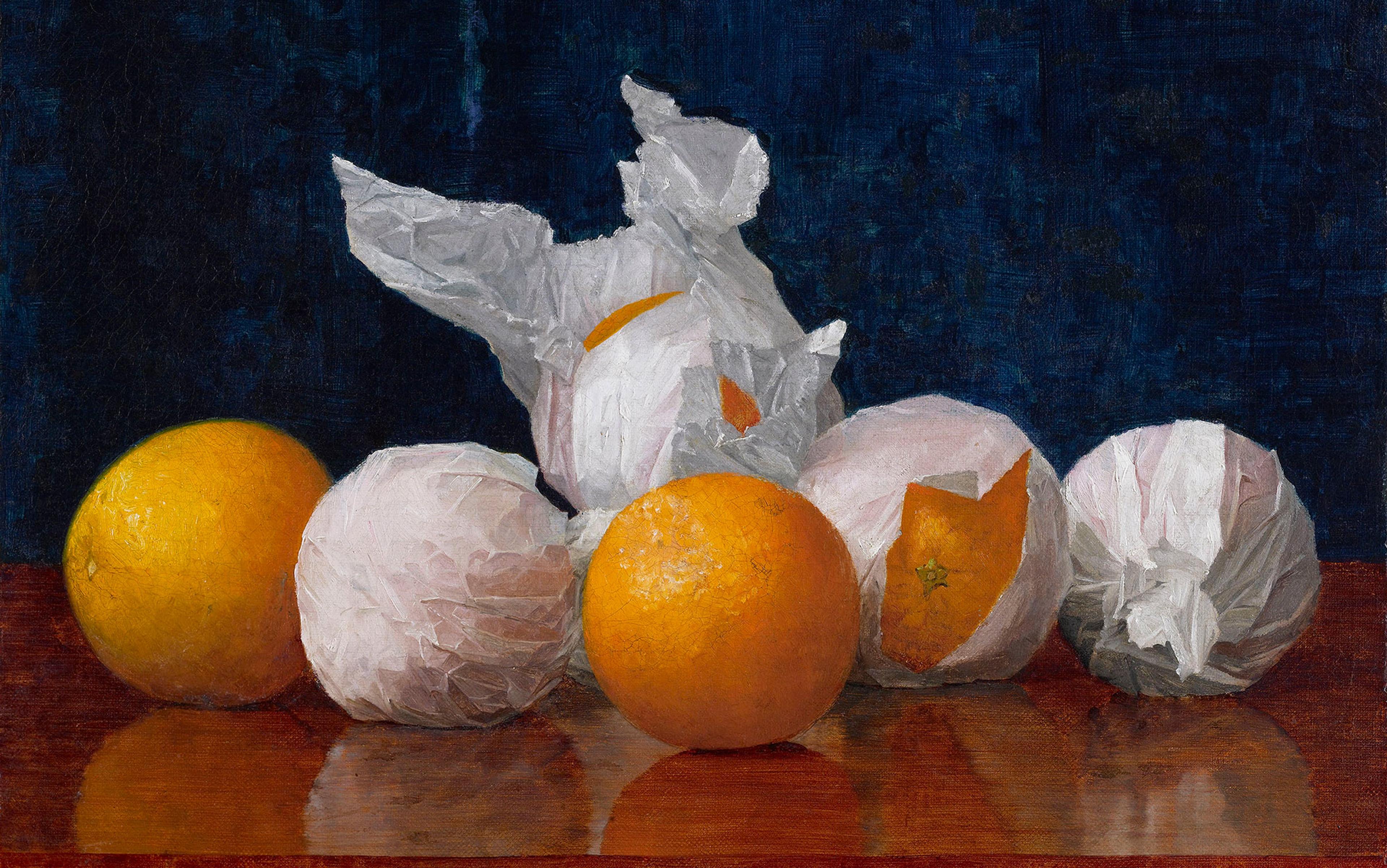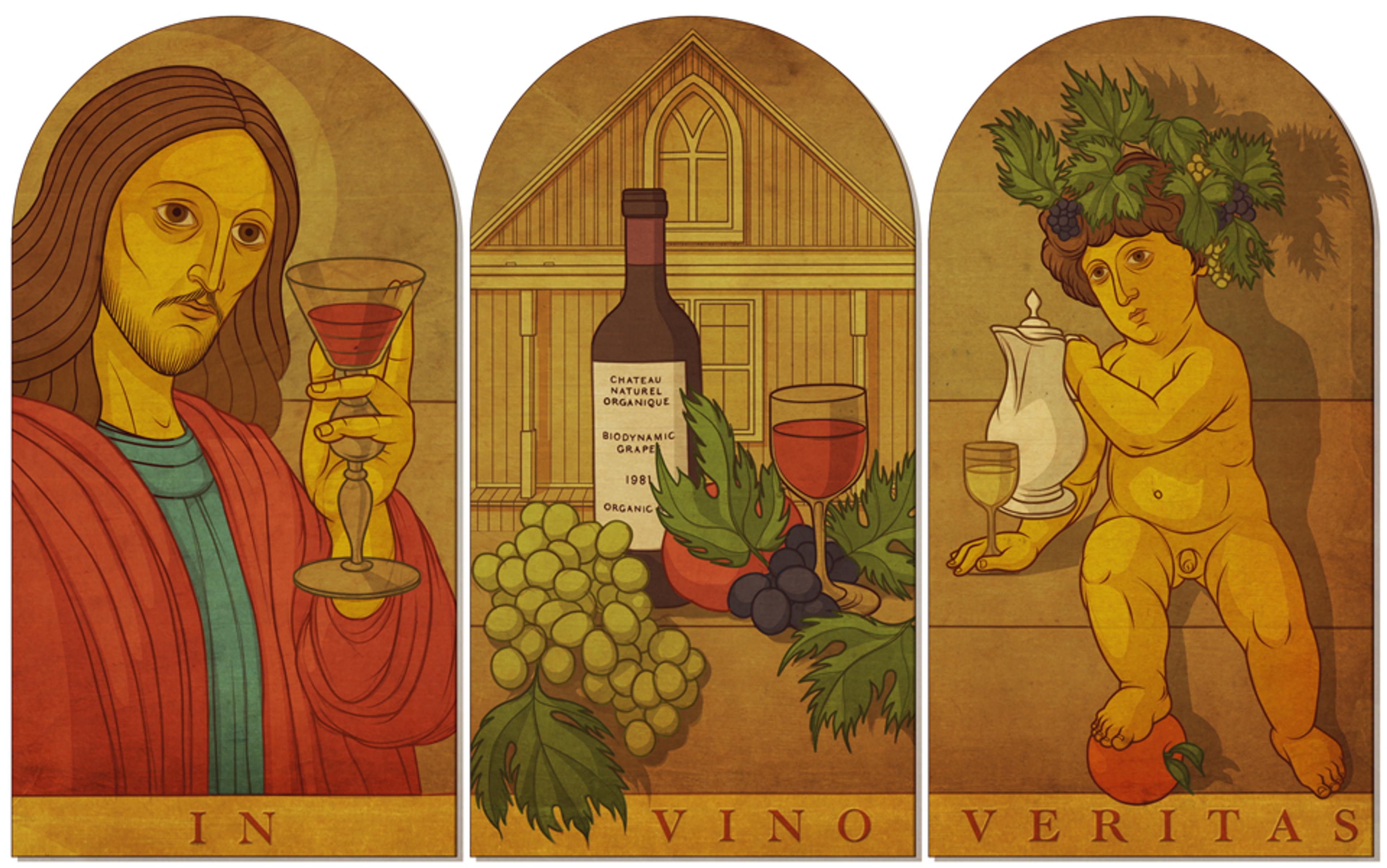Few foods can compete with olive oil. Its salubrious properties have turned it into one of the most recognisable symbols of healthy living as well as a sign of tacit resistance to the industrialisation of food and loss of authentic flavours. Its rich history, stretching back to the Greeks, Egyptians and Babylonians, plays an enormous part in its ongoing symbolic associations. Across a range of Mediterranean cultures, olive oil has been an inordinately versatile and useful product, even regarded as a means of connecting with the divine. Today, it sells in pricy green bottles that promise a ‘Mediterranean’ lifestyle. And yet, the distinctive flavour of extra virgin olive oil is a modern invention. The trail of its peppery note leads straight to the core of the Industrial Revolution and the reinvention of olive oil as a global commodity.
Homer calls Odysseus polytropos, a man of many ways, who can transform himself and adapt to any situation. Olive oil is often involved in these transformations, as when, on his return to Ithaca, Odysseus relies on olive oil – and Athena’s intervention – to become younger, stronger and more beautiful. He also carved his wedding bed in an olive tree that had grown deeply into the ground. These references are not incidental: the olive tree and the juice of its fruit are ancient symbols of vitality and rootedness. In Mediterranean cultures they signify adaptation, gnarly endurance and endless transformative possibilities.

Amphora depicting olive-gathering, made in Attica, Greece, 520 BCE. Courtesy the British Museum
First domesticated somewhere in the Fertile Crescent, the tree was cultivated by Babylonians, and by the 18th century BCE the Code of Hammurabi regulated the trade in olive oil. The tree steadily inched west, with its main centres of diffusion in Palestine, Syria and Crete. By the 5th century BCE, Thucydides felt he knew what separated civilisation from barbarism: the ability to graft the olive tree. The mythical foundation of Athens begins with the goddess Athena gifting the olive tree to the Greeks. Planting an olive grove was thus a sacred act. Especially revered were those trees whose oil served as prizes for the winners of the Panathenaic Games. In the 4th century BCE, cutting down or uprooting one of those trees could be punished with exile and confiscation of property. To this day in Italy, spilling oil on the table is viewed as a bad omen.
The Romans too loved their olive oil, which they consumed in mindboggling amounts. Monte Testaccio in Rome looks like a natural hill, but it’s an immense pile of broken oil amphoras (tall jars), which were used only once to prevent rancidness. During the imperial age, more than 1 million people lived in Rome, each one consuming an average of two litres of oil per month. How was it even possible? They appreciated oil as food, but they used it mainly for other purposes, such as lighting their houses and anointing their bodies. ‘Wine inside and oil outside,’ sums up Pliny the Elder, who considered olive oil ‘an absolute necessity’ of human life.
It’s not difficult to see why. Due to its antiseptic and calming properties, olive oil was used to clean, treat and beautify the body. In ancient medicine, olive oil was ‘the great healer’, and athletes were given deep friction massages with it to cure and prevent injuries. Warriors, too, smeared themselves with olive oil and used it to prevent their swords from rusting, as it’s an excellent solvent and lubricant. Olive oil also belonged to the world of perfumes. Exotic essences were layered in a clarified olive oil medium to obtain fragrances that were more subtle and persistent than those familiar to us, which are carried by alcohol. Pliny lists a dozen uses for olive oil, including smearing one’s face, hair and teeth with it. ‘The whole Mediterranean,’ wrote Lawrence Durrell, ‘seems to rise in the sour pungent taste of these black olives between the teeth. A taste older than meat, older than wine. A taste as old as cold water.’
The history of olive oil is the history of a persistent fascination. An all-pervasive presence across the ancient Mediterranean world, it continued to be seen as the purest and most eloquent way to exhibit close relations with the divine in the monotheist traditions of Judaism, Christianity and Islam. Its allure survived the impact of modernity. Since the 1950s, olive oil has enjoyed a renewed global reputation as a ‘healthy fat’. It is the cornerstone of the so-called Mediterranean Diet, a food pattern that incorporates practices from Greece and southern Italy, and that advertises itself as a salubrious way of life correlated to high life expectancy and low rates of diet-related chronic diseases. Rich in oleic acid and natural antioxidants, olive oil was marketed to American and north European consumers as a solution to the chronic ailments brought on by industrial methods and additives. The diet became an Intangible Cultural Heritage of Humanity in 2013. To imbibe olive oil is to enter into what the anthropologist Anne Meneley calls the ‘imaginaries of the Mediterranean’ as a site of real food and of slow and authentic forms of sociability, the combination responsible, it has been argued, for the higher number of centenarians in this region.
Nostalgia for traditionally made food and its authentic flavours is obviously not unique to olive oil. Oil producers are, however, extraordinarily successful at mobilising nostalgic narratives. The images of an archaic, mythical Mediterranean pervade the labels for what is now often acronymised to EVOO (extra virgin olive oil). The labels contain recurring terms that gesture toward traditional production methods: olives are ‘stone-crushed’, and oil is ‘cold pressed’ or ‘unfiltered’. These terms, like other commonly used descriptors, are not telling you much about the bottle’s content and the sensory experience you’re likely to have. Unlike well-designed wine labels, olive oil labels are mostly about evocation. Those weirdly shaped bottles in dark green glass evoke Mediterranean living, and promise to guard our kitchens against the relentless industrialisation and commodification of food.
Olive oil is one of a handful of foods whose quality is legally determined by its flavour
But there is always trouble in paradise. As denounced in Tom Mueller’s book Extra Virginity (2012), the sublime world of olive oil has a scandalous underbelly. Due to its high price and limited supplies, it is one of the most adulterated and mislabelled foods in the world. Pick a bottle of EVOO in a supermarket, and there is a good chance that it would not be recognised as extra virgin by a professional tasting panel. It might even be a concoction of heavily processed low-grade oils stripped of sensory qualities and health benefits, or it might contain substances that have nothing to do with olive juice. Mueller lamented the sheer vagueness of the term ‘olive oil’, which can refer to several different products, including refined industrial oils. And he introduced the reader to the ‘extra virgin’ denomination, which is a way of gesturing toward the authenticity and purity of the product, and of imposing order in an unruly oil world. The denomination dates back to a 1960 European law that created oil grades to standardise quality control and regulate trade. But what does it mean exactly?
I did not fully grasp it until I decided to up my olive oil game, following an interest in the history of olive oil technology. I received technical training at the National Organisation of Oil Tasters (ONAOO) in Imperia, Italy, an association that pioneered the modern tasting method for olive oil. Unlike other food-processing technologies, modern olive oil machinery has been constantly tested and modified based on the resulting flavour of the product. To this day, the oil is one of a handful of foods whose quality is legally determined by its flavour. Intriguingly, flavour was key even when olive oil was not produced for use, primarily, as food. I figured that there must have been a connection between machinic modernity and the ideal flavour of olive oil, which meant I had to learn how to taste it.
Training at ONAOO consists of acquiring a set of skills codified in tasting protocols, which are then used to sort and grade olive oil. This method enables oil tasters to have a shared language, much like the extravagant terms used by wine tasters to convey their sensations. I learned to look for perceptible fruitiness, quantify its presence and discern subtle fragrances and flavours, captured by terms like ‘artichoke’, ‘fresh-cut grass’ or ‘green tomato’. I also learned that bitterness and pepperiness are desirable. Most of the training, however, focused on identifying far less pleasant attributes, labelled by terms like ‘fly’, ‘frost’, ‘heated’, ‘greasy’, ‘mould’, ‘rancid’ or ‘sludge’. They sound disgusting, which they are, no matter how many apples you bite between one sip and the next. These attributes reveal that a problem occurred during the production process – the olives were compromised by a parasite; or not properly processed; or the oil was poorly preserved; or adulterated. An extra virgin olive oil should have no detectable defects. The oil taster is, above all, a defects seeker.
The International Olive Council (IOC) states that the main requirements for an oil to be classified as extra virgin are an absence of defects in its flavour, a perceptible fruitiness, and certain chemical properties – like a free acidity lower than 0.8 per cent. Pepperiness can indicate that the olives were harvested at the right time, before they were fully ripe, and that they were processed promptly, so that no fermentation occurred. This, in turn, is an indicator that this oil’s acidity is likely to be low. Oil acidity cannot be ascertained by tasting, but one can taste flavours that function as proxies for low acidity.
Extra virginity evokes a preindustrial world where families use ancient stones to grind locally picked olives
The IOC also states that extra virgin olive oil must be extracted from olives through a sequence of strictly mechanical operations, such as grinding and pressing or, more commonly today, centrifugation. No chemicals should ever be used, and the temperature during the process should not rise above 80.6°F (27°C). A higher temperature facilitates extraction but alters the oil’s organoleptic (or sensory) properties. Hence the significance of ‘cold pressed’. Strictly speaking, most extra virgin olive oil today is not ‘pressed’, as it’s not processed through presses, let alone stones – and thus ‘cold extraction’ is often a more appropriate descriptor. References to presses and stones gesture toward traditional methods as guarantors of quality.
The myth of traditional methods, however, is questionable. Marcello Scoccia, a blender and sensory analyst at leading companies for the past 40 years, ran the course I took at ONAOO. Cutting an elegant figure, he thoughtfully handles the tasting cup, and firmly believes in what he describes as scientific rigour applied to oil tasting. ‘If you are looking for consistent quality,’ he noted with a smirk, ‘then cutting-edge continuous-cycle mills are the safest bet.’ Continuous cycle means that olives are processed through centrifuges and steel machinery, within a few hours of harvesting. Stones and family-run mills are good for marketing, he conceded, but they are more difficult to operate, and many things can go wrong. And yet, the connection with traditional machinery and methods, however imaginary, is the main way to communicate ‘quality’ to consumers. Extra virginity evokes a romanticised preindustrial world where families use ancient stones to grind locally picked olives.
But how did we come to believe that what was codified in the notion of extra virginity captures the essence of what olive oil is and always was? The underlying assumption is that oil production has a timeless quality, and is based on practices and technology that have stayed constant for centuries, if not millennia, only to be corrupted by new industrial methods between the 19th and 20th century. It’s another version of the misleading narrative that portrays traditional practices as static, non-creative and destined to be wiped away by modern technological innovation. In Silicon Valley’s lore, disruption and radical innovation are positive values. In the case of oil, and food more generally, it’s come to be the opposite: innovation corrupts venerable traditions and threatens people’s health and identities. But the model of change underlying both narratives is similar. And it’s wrong.
Olive oil technology has changed enormously through time, with innumerable regional variations. There was never a fixed set of ‘traditional’ machines, but rather shifts in local needs and Mediterranean trading patterns. Inevitably, flavour changed too. Current talk of traditional olive oil-making refers to a set of machines and procedures captured by a familiar imagery: a mill with one or two round stones, and a central screw press, which squeezes mesh bags filled with olive paste. Described as a legacy of a remote past, this technology is said to produce authentic olive oil, the ideal model for our contemporary extra virgin approximation. But how old were these machines, really?

Engraving of olive oil production, attributed to Jan Collaert, based on Jan van der Straet, c1594-98. Courtesy the Rijksmuseum, Amsterdam
In fact, they date to the second half of the 18th century, when olive oil production began to be consistently mechanised. At that time, these new standardised machines became popular among southern European oil producers. Described as the ‘new’ oil manufacture, they were perceived as modern and efficient, rooted in analytic reasoning rather than irrational tradition. Stones and presses had long been used, but now they were designed according to new specifications and inserted in an entirely new productive process. To their promoters, the new olive mills were the most visible sign that the spirit of Enlightenment had finally reached the shores of the Mediterranean.
The production of olive oil involved a few basic steps: olives were collected, stored, milled and pressed, then the oil was left to clear in special containers. Enlightened reformers and entrepreneurs modified each stage of this process. Stones for crushing the olives became bigger and were cut to maximise pressure. Mules were replaced with horses, oxen or, wherever possible, vertical waterwheels. Beam presses, an ancient and adaptable technology, were replaced by batteries of central screw presses. These were often mounted into structures that dramatically increased their force.
The greatest challenge was not building the mills, but convincing local labourers to work in them
But these modern and powerful mills could function only on one condition: increasing the workload of millers and transforming the nature of their labour. A mechanised plant equipped with two mills and a battery of six reinforced presses could process more than one batch of olives at a time, olive paste moving from one press to the next in an ordered sequence of carefully measured pressings. To operate the mill 24 hours a day demanded a precise choreography. The power source gave continuity to the process, allowing labour to be distributed efficiently, and the steps of the process followed each other so as to keep each machine constantly in use: milling, first pressing, second pressing, third pressing, and the washing of the olive remnants. An optimised Apulian mill of the 1780s could process eight full loads of olives in 48 hours. A local entrepreneur warned that ‘nothing is more damaging to a fully equipped oil mill than being at rest.’
The dawn of the Industrial Revolution in the Mediterranean took the form of modern oil mills. The greatest challenge for entrepreneurs was not building the mills, but convincing local labourers to work in them. Previous oil mills were operated by men and women for a few hours a day during winter, when other demands of farm work slackened. They worked under the guidance of an experienced chief miller, sometimes called a helmsman, who ruled the mill with an authority similar to that of ship captains. Entrepreneurs stripped chief millers of autonomy and implemented the new – mechanised and analytically ordered – productive process. Temporary workers were replaced by brigades of men who worked in shifts around the clock.
Resistance to this new discipline is well documented. Many entrepreneurs hired foreigners, provoking tensions and riots. After many failed experiments, French and Italian entrepreneurs had to give up establishing mechanised mills in certain regions of southern Europe, such as Corsica or Calabria. The trope of the ignorant and recalcitrant Mediterranean peasant-worker was used to explain these failures. In reality, the revolts signalled a crisis in the nascent post-feudal order. By the end of the 18th century, peasant insurrections would target the ‘new men’, the entrepreneurs who supported the philosophical principles of the Enlightenment, the political ideals of the French Revolution, and the analytic management of mechanised production.
Objections to the new mills went beyond riotous labourers. Some landowners and traders too were sceptical of the new machinery. Why? Weren’t new machines simply better than older ones? Well, it depends. Reformers argued for more powerful machines and for speeding up production. But these goals made sense only to those who were ready to exploit the rising international demand for oil and willing to transform the nature of olive oil to do so.
Most oil mills didn’t need much power because the olives they processed were ripe and already fermented, and thus easy to crush. The oil produced in this way had high acidity, which meant that it could be used for local consumption. It turned rancid fairly quickly, however, and didn’t travel well. By the mid-18th century, it was not suitable for meeting the rising demand for oil from northern Europe and colonial networks. Low acidity oil, by contrast, could preserve its properties when shipped over long distances. Fine low-acidity oils had been manufactured in small quantities since antiquity, mainly for medical and cosmetic purposes. The new trading opportunities turned this kind of oil into a highly profitable business for those Mediterranean elites who could invest in it. But, in order to do so, they needed to change what olive oil was, how it was made – and how it tasted.
To keep acidity low, olives had to be picked directly from the tree, before they were fully ripe. This meant that crushing them was harder: hence more power was needed. Habits and beliefs about storing and fermenting olives had to be swept away, together with entrenched expectations about the colour and flavour of good edible oil. The new oil was sweeter and clearer, with a distinctive peppery note, remarkably different from the pungent and dark oil consumed across the Mediterranean. Not everyone thought it tasted better. The popular classes continued to prefer the ‘common oil’ and, to the apparent surprise of enlightened physicians, they continued to have no trouble digesting it. Southern elites, by contrast, developed a taste for the light and delicate flavour of the new oil. They were, in any case, the only groups who could afford it and, where the new oil became established, everyone else had to consume its cheaper byproducts.
The delicate and peppery flavour of the new oil denoted new forms of subordination
Admittedly, international demand for olive oil was not yet driven by its value as food. Before 1800, no other known material could outperform olive oil as a fuel for illumination or a lubricant for industrial machinery. But common oil would not do, as it would get rancid too easily. A rancid oil would be smelly and smoky when burned, and it would decompose quickly when used as a lubricant. In the second half of the 18th century, the price of low-acidity oil was published regularly in London, and it could be twice the price of common oil. On a clear day, in the bay of the oil town of Gallipoli in southern Italy, one would count around 70 foreign vessels at anchor, most of them British and Dutch, queuing to be loaded with oil. A British vice-consul resided in town for the sole purpose of fostering the oil trade. It was in this context that the appearance and flavour of low-acidity oil became proxies for its market value as an industrial oil.
Modern oil-making not only brought the Enlightenment to the Mediterranean world, but also new capitalist forms of production. Up to that point, oil making had followed the logic of mixed property and communal rights. Modern oil-making, by contrast, could succeed only where entrepreneurs controlled the entire cycle of production, from harvesting to storage. That is to say, where capitalism reigned uncontested. One key challenge for entrepreneurs was how to discipline the Mediterranean peasant-worker. The delicate and peppery flavour of the new oil didn’t just denote new organoleptic properties but the establishment of new forms of subordination.
Then as now, mechanisation and automation are not neutral. They never are. They do not just speed up older ways of doing things. Historically, they always mark transformations that are social as well as technical. In the case of 18th-century oil technology, what was transformed was not only the machinery but the nature of the product – and of the social world and economic power structures organised around it. New mills and the new oil were not self-evident goals, nor were they determined by an ineluctable technological trajectory. Rather, they were the contested outcomes of a reorganised social life that dictated, among other things, who should benefit from oil production, and how.
Oil tasting is a sombre task. Tasters handle the tulip-shaped glass as if the oil were brandy, warming it with their palm. They look at the colour of the oil, then smell it to discern its fragrances. Then they take a large sip, and start sucking in air from the corners of their mouth. In this way, they coat their tongue with oil while channelling the aromas up into the nose, so that no flavours will be missed. The loud slurping noise is followed by a quieter sipping and note-taking. Tasting one oil can take up to 15 minutes. What are they looking for?
Behind the colourful descriptors designed to capture each subtle note are the qualities valued by enlightened oil entrepreneurs: flavours that were proxies for low acidity. These indicated that an oil was ready for global trade, and that it would fetch a high price on international markets. They communicated to the connoisseur that the oil was suitable as a long-lasting lubricant or lamp fuel. And also suitable for the refined palates of the affluent Mediterranean bourgeoisie – or, as a Portuguese writer put it – for the ‘delicate tables’. As such, the new flavours mocked the popular taste for common oil, which was now regarded as vulgar and unhealthy. Three centuries after that Mediterranean encounter with industrial capitalism, we are still tasting olive oil to discern whether it’s good for a machine.
Next time you dip a piece of bread into a good olive oil, savour it for a moment, and seek that peppery flavour on the back of your tongue. It’s a flavour that conveys the presence of healthy polyphenols, and that pepperiness is a celebrated protagonist of the Mediterranean lifestyle. Today, it signifies authenticity and a connection to ancient traditions. But that very pepperiness tastes much like the advent of industrial capitalism and the creation of modern power relations in the Mediterranean world. It tastes like the growing network of global shipping routes, and the increasing rotational speed of well-lubricated industrial machinery. It’s a flavour that announced the dawn of a new world, the flavour of mechanisation.






